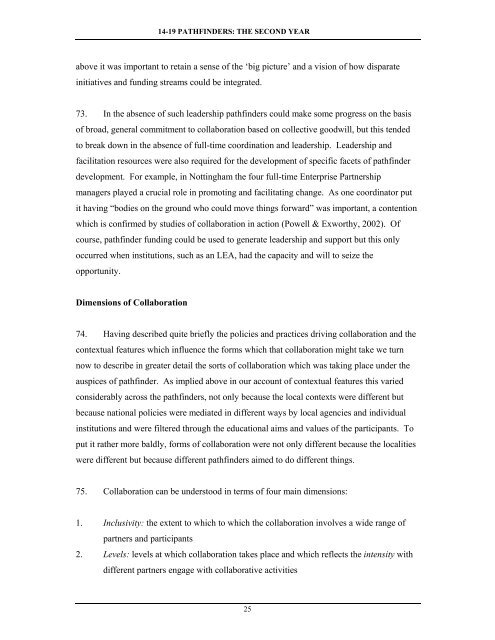Collaborative Approaches to 14-19 Provision - Communities and ...
Collaborative Approaches to 14-19 Provision - Communities and ...
Collaborative Approaches to 14-19 Provision - Communities and ...
- No tags were found...
You also want an ePaper? Increase the reach of your titles
YUMPU automatically turns print PDFs into web optimized ePapers that Google loves.
<strong>14</strong>-<strong>19</strong> PATHFINDERS: THE SECOND YEARabove it was important <strong>to</strong> retain a sense of the ‘big picture’ <strong>and</strong> a vision of how disparateinitiatives <strong>and</strong> funding streams could be integrated.73. In the absence of such leadership pathfinders could make some progress on the basisof broad, general commitment <strong>to</strong> collaboration based on collective goodwill, but this tended<strong>to</strong> break down in the absence of full-time coordination <strong>and</strong> leadership. Leadership <strong>and</strong>facilitation resources were also required for the development of specific facets of pathfinderdevelopment. For example, in Nottingham the four full-time Enterprise Partnershipmanagers played a crucial role in promoting <strong>and</strong> facilitating change. As one coordina<strong>to</strong>r putit having “bodies on the ground who could move things forward” was important, a contentionwhich is confirmed by studies of collaboration in action (Powell & Exworthy, 2002). Ofcourse, pathfinder funding could be used <strong>to</strong> generate leadership <strong>and</strong> support but this onlyoccurred when institutions, such as an LEA, had the capacity <strong>and</strong> will <strong>to</strong> seize theopportunity.Dimensions of Collaboration74. Having described quite briefly the policies <strong>and</strong> practices driving collaboration <strong>and</strong> thecontextual features which influence the forms which that collaboration might take we turnnow <strong>to</strong> describe in greater detail the sorts of collaboration which was taking place under theauspices of pathfinder. As implied above in our account of contextual features this variedconsiderably across the pathfinders, not only because the local contexts were different butbecause national policies were mediated in different ways by local agencies <strong>and</strong> individualinstitutions <strong>and</strong> were filtered through the educational aims <strong>and</strong> values of the participants. Toput it rather more baldly, forms of collaboration were not only different because the localitieswere different but because different pathfinders aimed <strong>to</strong> do different things.75. Collaboration can be unders<strong>to</strong>od in terms of four main dimensions:1. Inclusivity: the extent <strong>to</strong> which <strong>to</strong> which the collaboration involves a wide range ofpartners <strong>and</strong> participants2. Levels: levels at which collaboration takes place <strong>and</strong> which reflects the intensity withdifferent partners engage with collaborative activities25
















